Dovish, but not Fed dovish
EUR/USD has rallied for eight consecutive sessions. Up nearly 4% over June, it reached new highs of $1.1807 yesterday on a series of fresh dovish remarks from Treasury head Scott Bessent. Swaps are now more than fully pricing in a September Fed cut, with the chances of 3 cuts by year-end (two fully priced and 66.4% chance of a third).
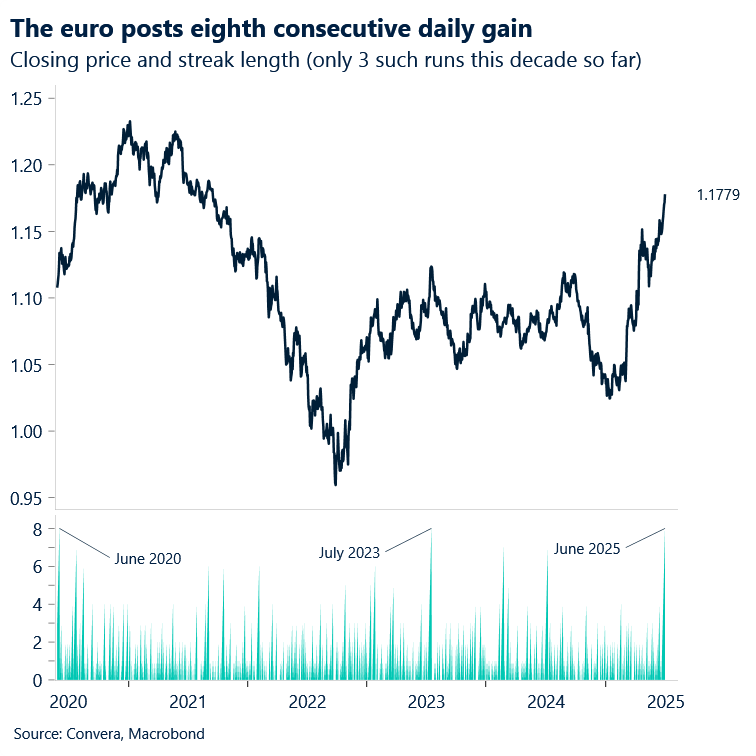
Bessent expressed confidence that inflation is on a downward path, described tariff-related price pressures as likely transitory, and critiqued the Fed for being “a little frozen at the wheel” on rates.
On the topic of Fed leadership, he outlined two succession routes ahead of Jerome Powell’s term ending in May 2026: filling a board seat opening in January with a new nominee, or elevating an existing governor. Among the latter, Governor Christopher Waller stands out. Nominated by Trump in his first term, Waller recently indicated rate cuts could begin as soon as July—a distinctly dovish stance that offers insight into the policy approach he might pursue as chairman. This longer-term dovish risk has added further weight on the dollar.
Now do you think the euro itself helped fuel this latest leg higher? Not quite. In fact, earlier in the London session, domestic eurozone data had actually capped further euro gains: ECB credit figures pointed to a weakening in the monetary transmission channel: lending to non-financial corporates fell in May—the first drop since last July—while household lending plateaued. This deceleration coincides with rising U.S. tariff risks and muted growth expectations, underscoring the need for a revival in credit dynamics. As disinflationary forces reassert with geopolitical tensions easing, markets increasingly view one final 25 bp cut in September as justified.
Adding to the case, German inflation eased to 2.0% in June (from 2.1%), hitting the ECB’s target for the first time in nearly a year. But the broader picture is more mixed: France and Spain saw renewed price pressures, while Italy held steady.
Attention now turns to today’s aggregate eurozone print, where expectations sit at 2.0%—a touch above May’s 1.9%. While policymakers are expected to hold in July, a softer-than-expected headline could tilt sentiment toward a more uniformly dovish path, potentially capping further EUR upside—barring any dollar-negative surprises from this week’s U.S. labour market data.
For now, though, focus remains firmly on the Fed’s dovish shift, keeping fundamental and sentiment-driven risks skewed to the upside for EUR/USD.
Back to basics: fundamentals lead
From a geopolitics-driven high of 99.421 as early as last week, the DXY tumbled over 2.5%, breaking below the 97 support level—repeatedly tested since the post-rally fade—suggesting room for further downside. Last time the greenback had navigated these shallow waters had been back in 2022.
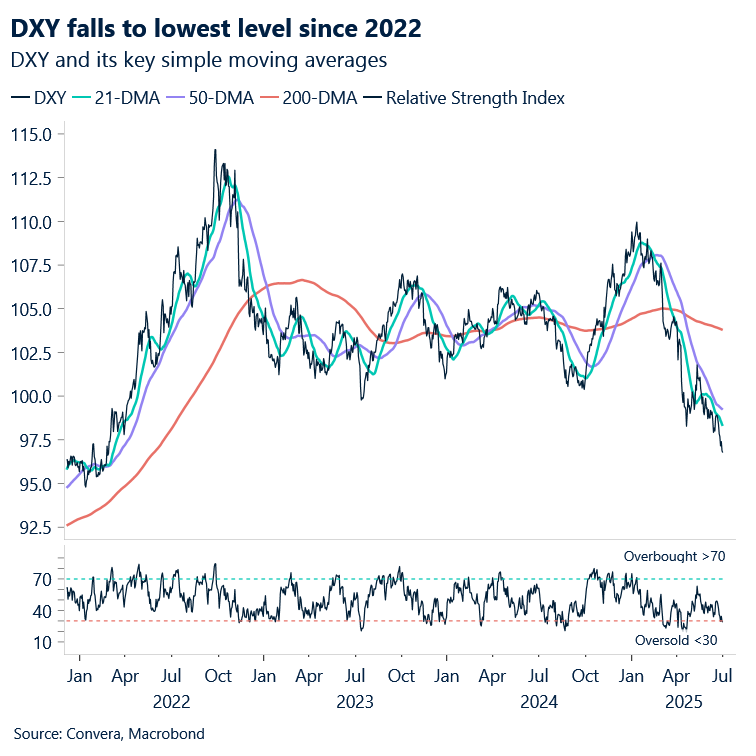
Three primary forces are steering dollar price action right now: trade developments, fiscal policy, and Fed expectations—with the latter currently commanding the market’s focus. Let’s break them down in order of dollar impact—from supportive to adverse:
Trade – supportive, although subdued for now. Progress continues on multiple fronts. Beyond the long-awaited deal with China finalized last week, Canada’s withdrawal of its digital services tax on tech giants has revived stalled U.S. trade talks. Trump, who had deemed the tax “a direct and blatant attack on our country,” had suspended all discussions pending its removal. Following its repeal, Trump and Prime Minister Carney committed to resuming negotiations, eyeing a July 21 agreement. Meanwhile, India extended its trade delegation’s stay in Washington by a day—pushing talks past the initial June 27 cutoff—as both sides seek to clinch a deal before the July 9 deadline. The extension has stirred hopes of an interim accord. Meanwhile, the EU is prepared to accept Donald Trump’s proposed 10% universal tariff on its exports, but is pushing for reduced rates on strategic sectors such as pharmaceuticals and semiconductors. The bloc, also, faces a July 9 deadline to finalize an agreement before tariffs on nearly all EU exports to the US surge to 50%.
For now, however, optimism around trade has had little impact on the dollar, with heightened expectations of Fed cuts continuing to dominate. A more supportive trade-related dollar narrative would likely require greater market conviction that the Fed’s dovish tilt is real (or not) and being priced accordingly, alongside more concrete, deal-centric trade developments.
2. Fiscal – mildly adverse. Attention turns to the Senate, where Trump is pushing to pass his $4.5 trillion tax-cut bill by July 4 but faces opposition from around eight republication senators who have concerns about the bill’s provisions. Markets remain wary: the Congressional Budget Office estimates the package would swell U.S. deficits by $3.3 trillion over the next decade—up from $2.8 trillion in the House version. The drag on the dollar here is less about the scale than the process: the rushed timeline, sparse detail, and not so much openness to amendments echo past policy moves, where uncertainty—not just substance—has weighed on the dollar. The comparison to tariffs is instructive.
3. The Fed – adverse. And especially so in today’s dollar-negative environment where cuts would make it cheaper for investors to hedge dollar exposure, as hedge costs are closely tied to interest rate differentials. While a more pronounced dovish tone is beginning to emerge (see Bessent’s remarks above), this week’s labor data—JOLTS (Tuesday), ADP (Wednesday), and NFP (Thursday)—will be pivotal. Assuming trade and fiscal dynamics remain unchanged, a firm jobs report coupled with contained inflation could help reprice September rate cut expectations, offering renewed support for the greenback.
For now, Fed expectations remain in the driver’s seat. We know that markets seek confirmation or contradiction, not mere continuation. And, on the policy front, investors are still in the process of characterizing the Fed as meaningfully dovish—but we’re not quite there. With the macro picture still mixed and inflation expected to tick higher, full pricing of that dovishness remains unlikely. This hesitation is amplifying the weight of policy expectations over other drivers. Now, as data in the coming weeks either validates or challenges the softer Fed tone— and assuming trade momentum holds—the balance of risks may increasingly tilt toward dollar support.
Sterling’s strongest H1 in over a decade
The pound softened across the board yesterday, paring some of last week’s gains as quarter-end flows drove positioning adjustments. The move appeared largely mechanical, with sterling’s broader trend still impressive—on track to post gains for a fourth straight month against the dollar.
With a quarterly rise of over 6%, this marks sterling’s strongest three-month stretch since late 2022, when it rebounded from the sharp losses during the Truss mini-budget fallout. Combined with Q1’s 3.2% gain, this year marks the best first half for the pound since 2020.
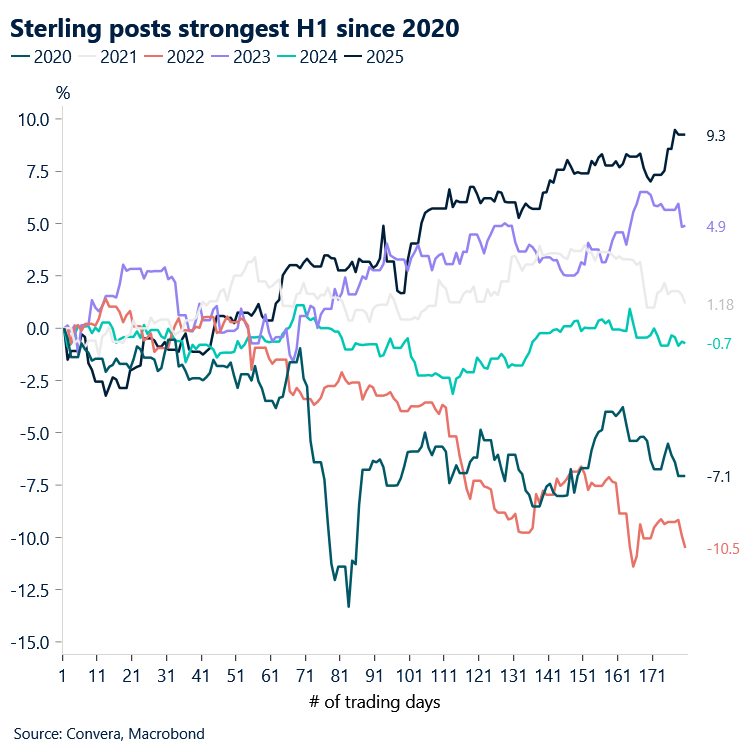
However, much of this year’s strength has stemmed from broad-based dollar weakness. President Donald Trump’s tariff policies—despite signs of progress—have rattled markets and dented confidence in the dollar, now further pressured by the Fed’s recent dovish shift.
That said, domestic fundamentals continue to cloud the outlook. A stagnant UK economy, persistently cool data flow, and a dovish-leaning BoE remain the chief headwinds for sterling as we move into H2.
USD weakness drives sterling and euro higher
Table: 7-day currency trends and trading ranges
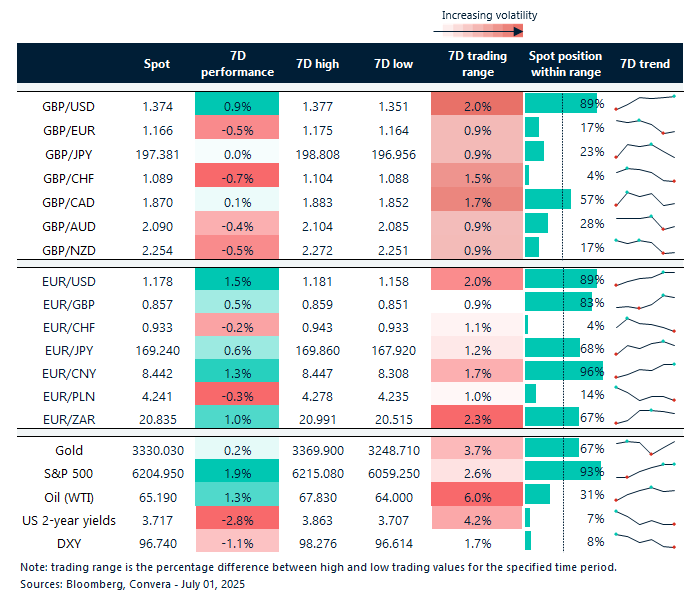
Key global risk events
Calendar: June/July 30-4
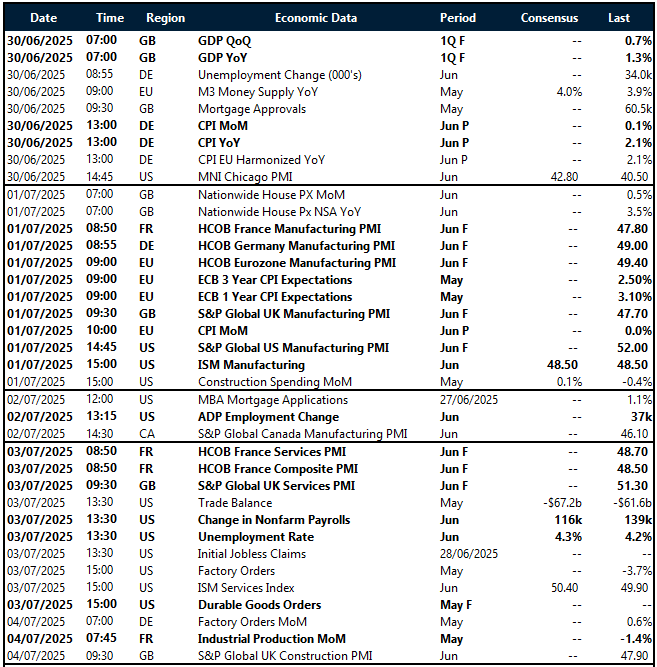
All times are in BST
Have a question? [email protected]
*The FX rates published are provided by Convera’s Market Insights team for research purposes only. The rates have a unique source and may not align to any live exchange rates quoted on other sites. They are not an indication of actual buy/sell rates, or a financial offer.



